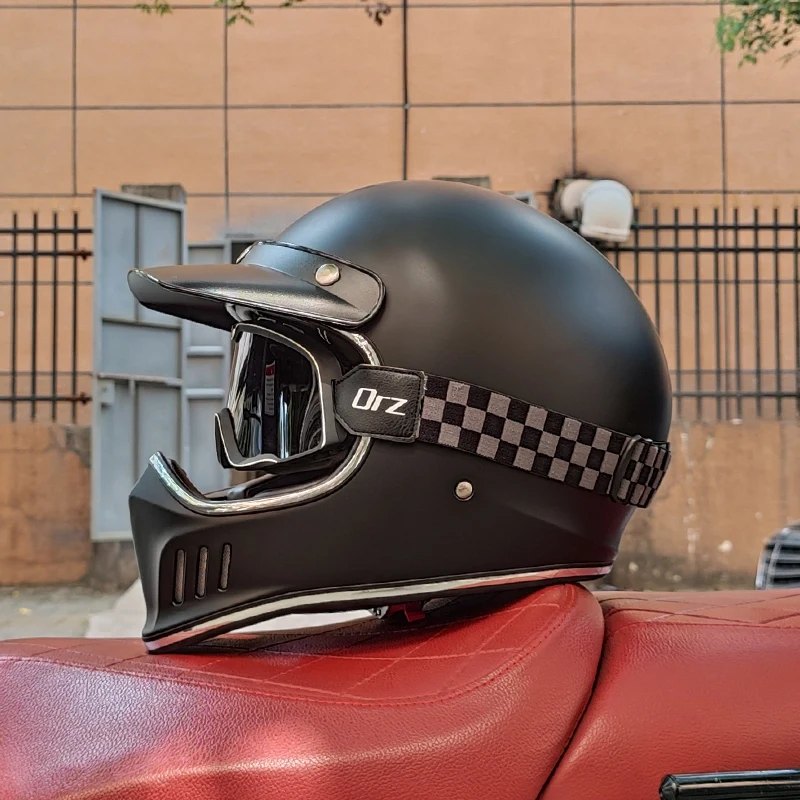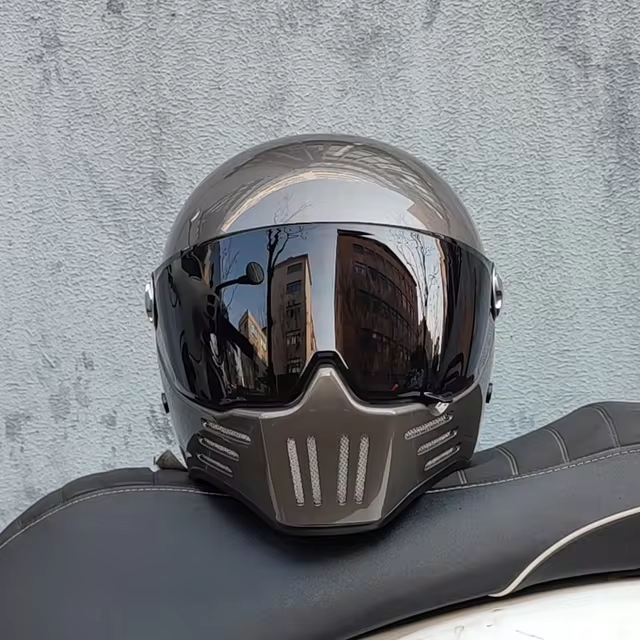Introduction to Cruiser Motorcycle Helmets
Cruiser motorcycle helmets are not just essential safety gear for riders but also a significant element of the cruiser motorcycle culture. Designed to offer maximum protection while complementing the relaxed and stylish nature of cruiser bikes, these helmets blend functionality with aesthetic appeal. Whether you’re a seasoned rider or new to the world of cruising, understanding the various types, features, and considerations of cruiser motorcycle helmets is crucial for both safety and style on the road.
The Importance of Choosing the Right Cruiser Motorcycle Helmet
Safety First: Protection Comes Standard
The primary function of any motorcycle helmet is to protect the rider’s head in the event of an accident. Cruiser motorcycle helmets are engineered to absorb impact, reducing the risk of traumatic brain injuries. They undergo rigorous testing to meet safety standards such as DOT (Department of Transportation), ECE (Economic Commission for Europe), and Snell certifications. Selecting a helmet that meets or exceeds these standards ensures that you have reliable protection while enjoying your ride.
Enhancing Visibility and Communication
Modern cruiser helmets come equipped with features that enhance visibility and communication. Many helmets integrate with communication systems, allowing riders to stay connected without taking their hands off the handlebars. Additionally, advanced helmet designs include improved ventilation systems and tinted visors to reduce glare and improve visibility in various lighting conditions. These features not only contribute to safety but also enhance the overall riding experience.
Comfort and Fit: The Basis of Helmet Selection
A well-fitted helmet is paramount for both safety and comfort. Cruiser motorcycle helmets are available in various sizes and shapes to accommodate different head types. It is essential to try on multiple helmets to find one that fits snugly without causing discomfort. Look for helmets with adjustable padding and ventilation systems to ensure a comfortable ride, even on long journeys.
Key Features to Consider in Cruiser Motorcycle Helmets
Material and Construction
The material and construction of a helmet play a significant role in its protective capabilities. Cruiser motorcycle helmets are typically made from various materials, including:
- Fiberglass Composite: Offers a good balance of strength and weight, making it a popular choice for many helmets.
- Polycarbonate: Known for its durability and affordability, polycarbonate helmets are a practical option for budget-conscious riders.
- Kevlar and Carbon Fiber: These materials provide superior strength and lightweight properties, often found in high-end helmets designed for performance and long-term use.
The inner shell, usually made of expanded polystyrene (EPS), is crucial for impact absorption. Ensure that the helmet you choose has a high-quality EPS liner that meets safety standards.
Ventilation Systems
Effective ventilation is essential for maintaining comfort during long rides, preventing fogging of visors, and reducing heat buildup inside the helmet. Cruiser motorcycle helmets come with various ventilation features, such as:
- Intake and Exhaust Vents: Positioned strategically to allow fresh air in while expelling hot air out.
- Adjustable Vents: Enable riders to control the airflow based on their comfort needs.
- Coolant Channels: Help distribute air evenly throughout the helmet, enhancing overall ventilation efficiency.
Visor Options
The visor is a critical component of cruiser motorcycle helmets, affecting visibility and protection from the elements. Key considerations include:
- Tinted Visors: Reduce glare and protect eyes from UV rays, making them ideal for sunny conditions.
- Photochromic Visors: Automatically adjust their tint based on ambient light, providing optimal visibility in varying conditions.
- Removable and Interchangeable Visors: Allow riders to switch visors easily based on their riding environment and personal preferences.
Noise Reduction
Cruiser motorcycle helmets are designed to minimize wind noise, enhancing rider comfort and reducing fatigue during long rides. Features that contribute to noise reduction include:
- Thicker Padding: Helps absorb and dampen sound.
- Streamlined Designs: Reduce wind turbulence around the helmet.
- Noise-Isolating Visors: Prevent wind from entering through the face area, maintaining a quieter riding experience.
Weight and Aerodynamics
A lightweight helmet can significantly reduce neck strain and increase comfort, especially during extended periods of riding. Cruiser motorcycle helmets prioritize both weight and aerodynamics by using materials and designs that minimize drag while maintaining structural integrity. Streamlined shapes and balanced weight distribution contribute to a more comfortable and efficient ride.
Designing for Style: Aesthetic Considerations
Classic and Retro Designs
Cruiser motorcycle helmets often feature classic and retro designs that reflect the timeless aesthetic of cruiser bikes. These helmets typically include:
- Glossy Finishes: Provide a polished and stylish appearance.
- Chrome Accents: Add a touch of sophistication and align with the chrome elements commonly found on cruiser motorcycles.
- Vintage Graphics: Incorporate classic patterns and designs that resonate with traditional cruiser culture.
Customization and Personalization
Personalization is a key aspect of cruiser motorcycle culture, and helmets are no exception. Many helmet manufacturers offer customization options, allowing riders to choose colors, graphics, and finishes that reflect their individual style. From bold graphics to understated elegance, customizing a cruiser helmet enables riders to express their personality while ensuring their helmet remains unique.
Integrated Features for Enhanced Aesthetics
Modern cruiser motorcycle helmets often come with integrated features that enhance both functionality and style, such as:
- Built-in Lighting Systems: Add visibility and a stylish edge to the helmet.
- Reversible Liners: Offer versatility in color and style, allowing riders to switch up their helmet’s appearance with ease.
- Decorative Straps and Buckles: Provide aesthetic appeal while ensuring secure helmet fastening.
Technological Innovations in Cruiser Motorcycle Helmets
Advanced Materials for Improved Safety and Comfort
The evolution of materials has significantly impacted the design and functionality of cruiser motorcycle helmets. Innovations include:
- MIPS (Multi-directional Impact Protection System): A technology that reduces rotational forces on the brain during angled impacts, enhancing safety.
- 3D-Printed Interiors: Offer a more personalized fit by molding closely to the rider’s head shape, improving comfort and stability.
- Integrated Communication Systems: Allow riders to connect with each other or access GPS and music without removing their helmets.
Smart Helmet Features
Smart helmets are becoming increasingly popular among cruiser riders who seek a blend of technology and safety. These helmets incorporate features such as:
- Heads-Up Displays (HUD): Provide real-time information, such as speed, navigation directions, and incoming calls, directly in the rider’s line of sight.
- Bluetooth Connectivity: Enables hands-free communication and integration with smartphones and other devices.
- Built-in Cameras: Allow riders to capture their journeys and share their experiences with others.
Enhanced Ventilation and Cooling Systems
Modern cruiser motorcycle helmets feature advanced ventilation and cooling systems to maintain rider comfort in various weather conditions. Innovations include:
- Active Cooling Systems: Utilize small fans or cooling gel pads to regulate temperature inside the helmet.
- Optimized Airflow Paths: Ensure maximum airflow without compromising the helmet’s structural integrity or aerodynamic properties.
- Moisture-Wicking Liners: Keep riders dry by absorbing sweat and promoting air circulation.
Selecting the Right Cruiser Motorcycle Helmet: A Step-by-Step Guide
Assessing Your Riding Needs
Before selecting a cruiser motorcycle helmet, it’s essential to evaluate your specific riding needs. Consider factors such as:
- Riding Environment: Whether you primarily ride in urban settings, on highways, or on long-distance trips can influence the type of helmet you need.
- Frequency of Use: Regular riders might prioritize durability and comfort, while occasional riders might focus on style and ease of use.
- Personal Preferences: Your aesthetic preferences and desired features will play a significant role in selecting the right helmet.
Measuring and Sizing
Proper sizing is crucial for both safety and comfort. Follow these steps to ensure a proper fit:
- Measure Your Head Circumference: Use a flexible tape measure to determine your head circumference just above the eyebrows and ears.
- Refer to Size Charts: Compare your measurements with the manufacturer’s size chart to find the appropriate size.
- Try Before You Buy: If possible, try on multiple helmets to assess fit and comfort. Ensure there is no excessive movement or pressure points.
Checking for Safety Certifications
Always verify that the helmet meets relevant safety standards. Look for labels or markings indicating compliance with DOT, ECE, or Snell certifications. These certifications ensure that the helmet has undergone testing for impact resistance and other safety criteria.
Exploring Price and Quality Balance
While it might be tempting to choose the most affordable option, investing in a high-quality helmet is crucial for safety and longevity. Consider the following when balancing price and quality:
- Material Quality: Higher-quality materials typically offer better protection and durability.
- Brand Reputation: Established brands often provide more reliable products and better customer support.
- Warranty and Support: A good warranty can provide peace of mind and protect your investment.
Trying On and Testing the Helmet
After selecting a helmet, it’s important to try it on under real riding conditions to ensure comfort and functionality:
- Wear the Helmet Properly: Ensure all straps are fastened correctly and the helmet sits level on your head.
- Check for Pressure Points: Ensure there are no areas causing discomfort or excessive pressure.
- Move Your Head: Turn, tilt, and move your head to ensure the helmet stays securely in place without shifting.
 Conclusion: Embracing Safety and Style with Cruiser Motorcycle Helmets
Conclusion: Embracing Safety and Style with Cruiser Motorcycle Helmets
Cruiser motorcycle helmets are a vital component of any rider’s gear, providing essential protection while enhancing the overall riding experience. By understanding the various types, features, and factors to consider, riders can make informed decisions that prioritize both safety and personal style. Whether you prefer the classic appeal of an open-face helmet or the comprehensive protection of a full-face model, selecting the right cruiser motorcycle helmet ensures that every journey is not only stylish but also secure.


